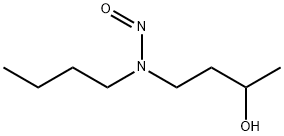N-Nitrosodibutylamine
Synonym(s):N-Nitrosodibutylamine;Dibutyl nitrosamine;NDBA
- CAS NO.:924-16-3
- Empirical Formula: C8H18N2O
- Molecular Weight: 158.24
- MDL number: MFCD00013892
- EINECS: 213-101-1
- SAFETY DATA SHEET (SDS)
- Update Date: 2024-12-18 13:37:16

What is N-Nitrosodibutylamine?
Chemical properties
N-Nitrosodi-n-butylamine is a yellow, oily liquid.
The Uses of N-Nitrosodibutylamine
N-Nitrosodi-n-butylamine is used primarily as a research chemical (IARC 1974). It has also been used as an intermediate in the synthesis of di-n-butylhydrazine.
The Uses of N-Nitrosodibutylamine
N-Nitroso-di-n-butylamine is a pollutant that can be found in water network systems.
Definition
ChEBI: N-Nitrosodi-n-butylamine is a nitroso compound.
General Description
Pale yellow liquid.
Reactivity Profile
N-NITROSODIBUTYLAMINE is a nitrated amine derivative. Amines are chemical bases. They neutralize acids to form salts plus water. These acid-base reactions are exothermic. The amount of heat that is evolved per mole of amine in a neutralization is largely independent of the strength of the amine as a base. Amines may be incompatible with isocyanates, halogenated organics, peroxides, phenols (acidic), epoxides, anhydrides, and acid halides. Flammable gaseous hydrogen is generated by amines in combination with strong reducing agents, such as hydrides.
Health Hazard
Inhalation of material may be harmful. Contact may cause burns to skin and eyes. Inhalation of Asbestos dust may have a damaging effect on the lungs. Fire may produce irritating, corrosive and/or toxic gases. Some liquids produce vapors that may cause dizziness or suffocation. Runoff from fire control may cause pollution.
Fire Hazard
Some may burn but none ignite readily. Containers may explode when heated. Some may be transported hot.
Safety Profile
Confirmed carcinogen with experimental carcinogenic, tumorigenic, and neoplastigenic data. Moderately toxic by ingestion, subcutaneous, and intraperitoneal routes. Experimental teratogenic effects. Human mutation data reported. When heated to decomposition it emits toxic fumes of NOx. See also NITROSAMINES.
Potential Exposure
N-Nitrosodi-n-butylamine is a carcinogenic nitrosamine. It is found or used in various manufacturing industries, including chemical, rubber, metal, etc., and in research.
Carcinogenicity
N-Nitrosodi-n-butylamine is reasonably anticipated to be a human carcinogen based on sufficient evidence of carcinogenicity from studies in experimental animals.
Shipping
UN2810 Toxic liquids, organic, n.o.s., Hazard Class: 6.1; Labels: 6.1-Poisonous materials, Technical Name Required. UN3082 Environmentally hazardous substances, liquid, n.o.s., Hazard Class: 9; Labels: 9-Miscellaneous hazardous material, Technical Name Required
Incompatibilities
N-Nitrosodi-n-butylamine is light sensitive. Nitrosamines can be strong oxidizers; contact with these materials may cause fires or explosions. Keep away from combustible materials, alkaline materials, strong acids, strong bases. Nitrated organics range from slight to strong oxidizing agents. If mixed with reducing agents, including hydrides, sulfides and nitrides, they may begin a vigorous reaction. Amines are a chemical base: will neutralize acids to form salts plus water with an exothermic reaction. May be incompatible with isocyanates, halogenated organics, peroxides, phenols (acidic), epoxides, anhydrides, and acid halides. Flammable gaseous hydrogen is generated by amines in combination with strong reducing agents such as hydrides, nitrides, alkali metals, and sulfides.
Waste Disposal
Consult with environmental regulatory agencies for guidance on acceptable disposal practices. Generators of waste containing this contaminant (≥100 kg/mo) must conform with EPA regulations governing storage, transportation, treatment, and waste disposal. Under 40 CFR 261.5 small quantity generators of this waste may qualify for partial exclusion from hazardous waste regulations.
Properties of N-Nitrosodibutylamine
| Melting point: | <25℃ |
| Boiling point: | 237 °C |
| Density | 0,9 g/cm3 |
| refractive index | 1.4485 (589.3 nm 20℃) |
| storage temp. | -20°C Freezer |
| solubility | Acetone (Slightly), Chloroform (Slightly), Ethyl Acetate (Slightly), Methanol (Slightly) |
| pka | -3.14±0.70(Predicted) |
| form | neat |
| form | Liquid |
| color | Clear Colourless to Light Yellow |
| Water Solubility | 1.199g/L(room temperature) |
| Stability: | Light Sensitive |
| CAS DataBase Reference | 924-16-3(CAS DataBase Reference) |
| IARC | 2B (Vol. 17, Sup 7) 1987 |
| EPA Substance Registry System | N-Nitrosodi-n-butylamine (924-16-3) |
Safety information for N-Nitrosodibutylamine
| Signal word | Warning |
| Pictogram(s) |
 Exclamation Mark Irritant GHS07  Health Hazard GHS08 |
| GHS Hazard Statements |
H302:Acute toxicity,oral H351:Carcinogenicity |
| Precautionary Statement Codes |
P202:Do not handle until all safety precautions have been read and understood. P264:Wash hands thoroughly after handling. P264:Wash skin thouroughly after handling. P270:Do not eat, drink or smoke when using this product. P280:Wear protective gloves/protective clothing/eye protection/face protection. P301+P312:IF SWALLOWED: call a POISON CENTER or doctor/physician IF you feel unwell. P308+P313:IF exposed or concerned: Get medical advice/attention. |
Computed Descriptors for N-Nitrosodibutylamine
N-Nitrosodibutylamine manufacturer
VIVAN Life Sciences Pvt Ltd
Synchemia Research Chemical
Naarini MolBio Pharma Pvt Ltd
New Products
Tert-butyl bis(2-chloroethyl)carbamate (S)-3-Aminobutanenitrile hydrochloride N-Boc-D-alaninol N-BOC-D/L-ALANINOL N-octanoyl benzotriazole 4-Hydrazinobenzoic acid 3,4-Dibenzyloxybenzaldehyde Electrolytic Iron Powder 1,1’-CARBONYLDIIMIDAZOLE R-2-BENZYLOXY PROPIONIC ACID 4-HYDROXY BENZYL ALCOHOL 1,1’-CARBONYLDI (1,2-4 TRIAZOLE) S-2-CHLORO PROPIONIC ACID (2-Hydroxyphenyl)acetonitrile 4-Bromopyrazole 5-BROMO-2CYANO PYRIDINE 5,6-Dimethoxyindanone 5-broMo-2-chloro-N-cyclopentylpyriMidin-4-aMine 3-(Hydroxymethyl)benzoate N-Boc-2-chloroethylamine 1-Bromo-2-methoxy-3-nitrobenzene N-Methyl-3-cyclopenten-1-amine 2-Bromo-3-hydroxybenzaldehyde 1H-indazole-5-carboxamideRelated products of tetrahydrofuran








You may like
-
 924-16-3 99%View Details
924-16-3 99%View Details
924-16-3 -
 924-16-3 98%View Details
924-16-3 98%View Details
924-16-3 -
 N-Nitrosodibutylamine CAS 924-16-3View Details
N-Nitrosodibutylamine CAS 924-16-3View Details
924-16-3 -
 N-Nitrosodibutylamine (NDBA) CAS 924-16-3View Details
N-Nitrosodibutylamine (NDBA) CAS 924-16-3View Details
924-16-3 -
 N-Nitrosodibutylamine 924-16-3 98%View Details
N-Nitrosodibutylamine 924-16-3 98%View Details
924-16-3 -
 N-Nitrosodibutylamine 98%View Details
N-Nitrosodibutylamine 98%View Details -
 N-Nitrosodi-n-butylamine CAS 924-16-3View Details
N-Nitrosodi-n-butylamine CAS 924-16-3View Details
924-16-3 -
 N-Nitrosodi-n-butylamine solution CAS 924-16-3View Details
N-Nitrosodi-n-butylamine solution CAS 924-16-3View Details
924-16-3